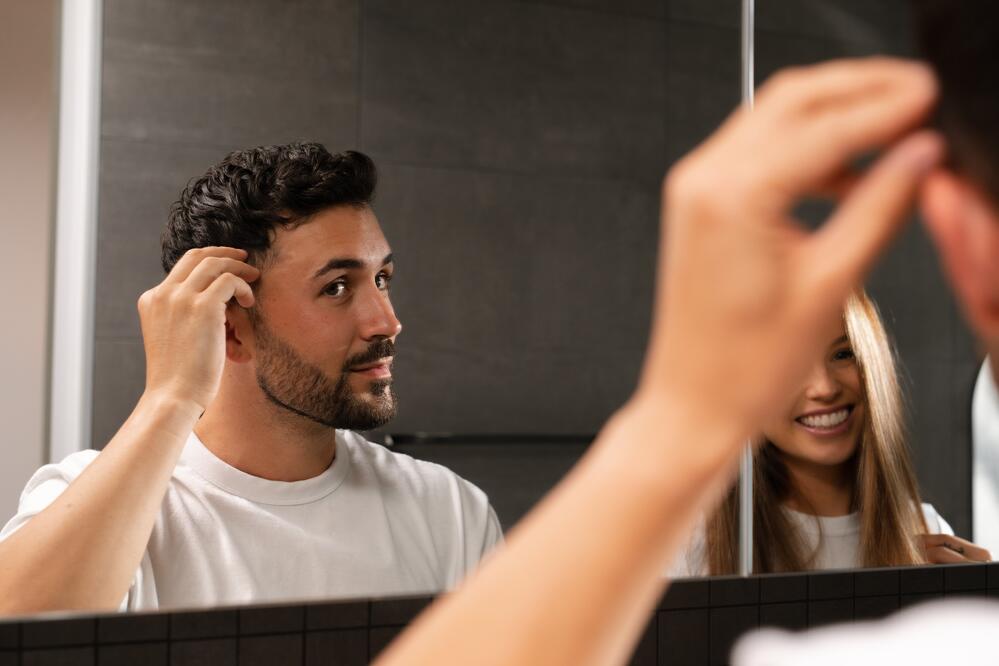What is now proved was once only imagined. Poet William Blake was probably not referring to hair loss treatment when he uttered these famous words, but they ring true when it comes to recent innovations in treating hair loss.
These days, we don’t just have to take genetic hair loss lying down. Scalp micropigmentation is one hair loss solution on the market, but what’s the reality behind the hype?
Scalp micropigmentation (SMP) is a non-invasive treatment for filling in a receding hairline or a thinning crown, but it has its limits.
In this article, we answer common questions about scalp micropigmentation and list its pros and cons.
Common questions about scalp micropigmentation
What exactly is scalp micropigmentation?
Scalp micropigmentation is a cosmetic treatment where pigment is implanted onto the scalp to create the illusion of a full head of hair. A skilled SMP artist creates tiny, layered dots in different shades to mimic natural hair follicles.
Does scalp micropigmentation look real?
Quality scalp micropigmentation should look like real hair follicles. The results should blend seamlessly with natural hair follicles, creating the illusion of a full head of hair on the scalp. That being said, skill-levels amongst providers can vary drastically, and poor results may look obvious and fake.
How long does scalp micropigmentation last?
SMP is a semi-permanent treatment. As with a tattoo, the treated area will fade over time as the skin cells renew. The effects usually last around 4-6 years, but you may need a top-up every couple of years. Although the treatment is semi-permanent, it can be removed with laser tattoo removal.
Does scalp micropigmentation grow hair?
No, scalp micropigmentation will not grow your hair back. It’s all about creating an illusion, which is why not all hairstyles will work with it. It creates the illusion of density, but doesn’t actually make your hair more dense when grown out. The only hair loss treatment that will grow back lost hair is a hair transplant.
What’s the difference between micropigmentation and a hair transplant?
Micropigmentation gives the illusion of hair, whereas a hair transplant replaces lost hair with your natural hair.
In an FUE micro-transplant hair transplant, individual hair follicles are extracted from the back and sides of the head, where the follicles are resistant to balding. The follicles are then implanted in the area where hair has been lost, and they’ll continue to grow there for a lifetime.
The benefits of a hair transplant include permanent results and natural growth, which allows you to cut, dye and style your hair as you like. With a quality transplant, nobody can tell you’ve had one.
The pros and cons of scalp micropigmentation
Pros
- Brings back the look of a thick stubble – say goodbye to comments about your receding hairline or bald spots!
- Affordability – usually between $1000-7000 depending on the provider and the extent of the procedure.
- It offers an alternative to those who can’t have or don’t want to have a hair transplant procedure or take medical hair loss treatment.
- Short recovery time – only a few days.
- Low maintenance – when it’s done, it’s done. All you need to do is shave your head every few days and top up the pigmentation every few years.
Cons
- Not a permanent solution – top-ups and new procedures are required every few years, so it’s an ongoing investment.
- While results fade, some pigment will stick around underneath your skin. It’s worth considering whether scalp micropigmentation is a look you’ll want when you’re older.
- Doesn’t grow back lost hair – the result is purely an illusion. You won’t get the stubble feel when running your fingers over your hair.
- Limits your hairstyles choices, as it doesn’t actually grow the hair back
- Risk of a botched job – results may fade or look unnatural if the micropigmentation provider is inexperienced or cuts corners.
So, should you go for scalp micropigmentation or a hair transplant?
The right treatment for you depends on many factors – your motivation, what type of results you want, your budget and more.
Some people are wary of hair transplants because the process involves procedure and the results are for life. Fair enough! The good news is that hair transplants have come a long way: our modern FUE microsurgeries here at Gro involve no cutting and no scarring. The results look completely natural, as our highly trained doctors implant the hair in a natural pattern.
That being said, scalp micropigmentation is a cheaper alternative. It won’t grow real hair, however, it’s a great solution if you’re ready to embrace a buzzcut but not a fully bald dome.
If you decide to go for scalp micropigmentation, just make sure to do your research and seek out a skilled and trusted SMP artist.
Want to find out more about hair transplants? Click the button below or see here for more information.













